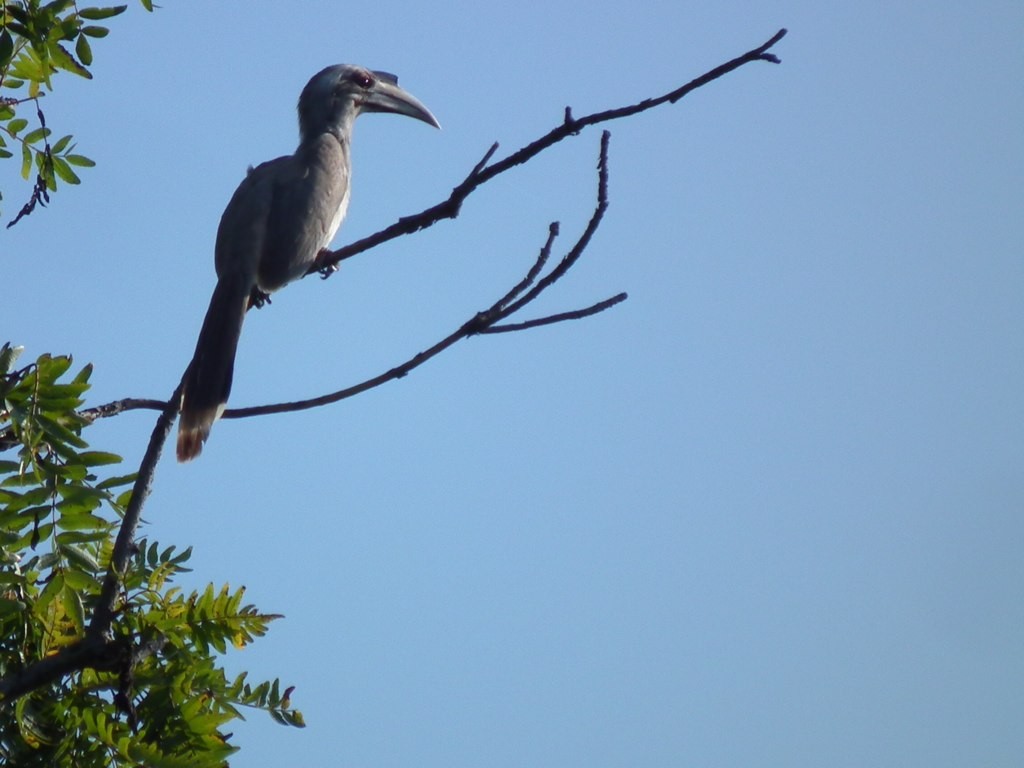Indian Grey Hornbill
A species of South Asian Gray Hornbills Scientific name : Ocyceros birostris Genus : South Asian Gray Hornbills
Indian Grey Hornbill, A species of South Asian Gray Hornbills
Botanical name: Ocyceros birostris
Genus: South Asian Gray Hornbills
Content
Description General Info
Description
The Indian grey hornbill is a medium-sized hornbill, measuring around 61 cm (24 in) in length. The upper parts are greyish brown and there is a slight trace of a pale supercilium. The ear coverts are darker. The flight feathers of the wing are dark brown with a whitish tip. The tail has a white tip and a dark subterminal band. They have a red iris and the eyelids have eyelashes. The casque is short and pointed. The male has a larger casque on a dark bill, and the culmen and lower mandible are yellowish. The bare skin around the eye is dark in the male, but sometimes pale reddish in females. The female has a more yellowish bill with black on the basal half and on the casque. The juveniles lack the casque, and the bare skin around the eye is dull orange. 
Size
50 cm
Colors
Gray
White
Nest Placement
Cavity
Feeding Habits
Indian Grey Hornbill primarily consume fruits including Streblus asper and Ficus spp. They also eat insects, scorpions, small birds, reptiles, and molluscs. They forage trees for food and have a unique adaptation of feeding on toxic Thevetia peruviana fruits.
Habitat
Indian Grey Hornbill primarily inhabits deciduous woodlands, parkland, and open thorn-forests, often found near scattered fig trees. They are adapted to a range of environments, from the plains to elevations around 2,000 feet, preferring areas with rural cultivation and gardens. Indian Grey Hornbill's range encompasses broad regions with a foothill to lowland preference, frequenting areas characterized by old avenue trees, including regions transitioning into urban settlements.
Dite type
Frugivorous
General Info
Feeding Habits
Bird food type

Fruit
Behavior
The call is a squealing call somewhat like that of a black kite. The flight is heavy and involves flapping interspersed with glides. They are found in pairs or small groups. The nesting season is April to June and the clutch varies from one to five very symmetrical white eggs. Indian grey hornbills usually nest in tree hollows on tall trees. An existing hollow may be excavated further to suit. The female enters the nest hollow and seals the nest hole, leaving only a small vertical slit through which the male feeds her. The nest entrance is sealed by the female using its excreta and mud-pellets supplied by the male. While inside the nest, the female moults her flight feathers and incubates the eggs. The regrowth of the female's feathers coincides with the maturity of the chicks, at which point the nest is broken open. A study at a nest near Mumbai noted that the key fruiting trees on which the hornbills fed were Streblus asper, Cansjera rheedii, Carissa carandas, Grewia tiliaefolia, Lannea coromandelica, Ficus spp., Sterculia urens and Securinega leucopyrus. They are also known to take molluscs, scorpions, insects, small birds (they have been recorded removing and possibly preying on rose-ringed parakeet chicks) and reptiles in their diet They are known to feed on the fruits of Thevetia peruviana, which are known to be toxic to many vertebrates. They are almost completely arboreal, but very rarely descend to the ground to pick up fallen fruits, to dust bathe, or to pick up mud pellets to seal the nest cavity during the nesting period. They indulge in various social activities, including bill-grappling and aerial jousting. 
Distribution Area
The species is found mainly on the plains up to about 2000 feet. It is found from the foothills of the Himalayas southwards, bounded to the west by the Indus system and to the east by the Ganges Delta. It may make local movements in the drier western region. It is found even in cities that have old avenue trees. It is found mainly on the plains up to about 1400 metres; The species has been observed, usually in pairs, in Dharamsala town (Himachal Pradesh) at about 1500 to 1600 masl during summer and in the rainy season (May to September, 2017). and does not overlap much with the Malabar grey hornbill of the Western Ghats. 
Species Status
Not globally threatened.
